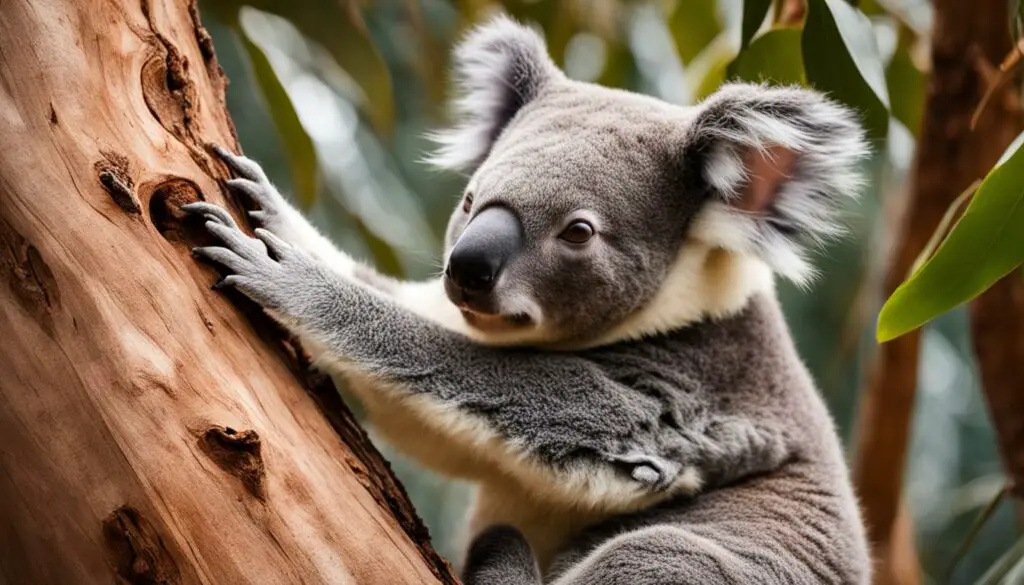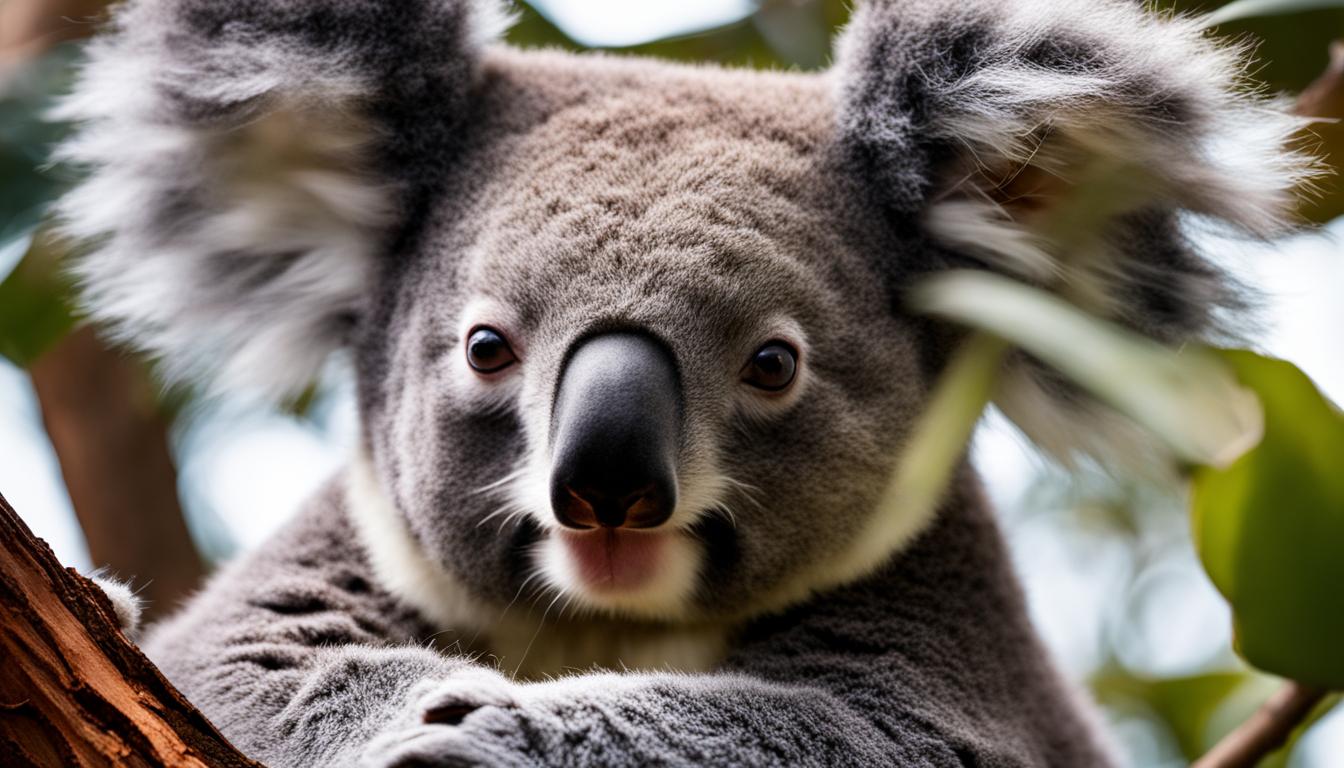Welcome to our article on koala adaptations! Koalas are fascinating creatures native to Australia, specifically found in the eastern and southern regions of the country. These adorable marsupials have a range of physical and behavioral adaptations that allow them to thrive in their unique habitat. Let’s delve into the world of koalas and discover how they have evolved to survive.
From their lean bodies and long, muscular limbs to their sharp claws and rough skin on their feet for climbing trees, koalas have an impressive array of physical adaptations. Their specialized digestive system helps them detoxify the toxic chemicals in eucalyptus leaves, their primary food source. Their thick fur coat not only regulates their body temperature but also provides cushioning when sitting on branches.
But koalas’ adaptations go beyond just their physical characteristics. These marsupials have behavioral adaptations as well. They are primarily nocturnal, which means they are most active during the night, allowing them to avoid potential predators and conserve energy during the day. Koalas also spend up to 20 hours a day sleeping, which helps them conserve energy and cope with their low-nutrient, high-fiber diet of eucalyptus leaves.
Despite their impressive adaptations, koalas face significant risks due to habitat loss, predation, and diseases like chlamydia. It’s essential to understand and appreciate these remarkable creatures, as well as take action to protect their habitats and ensure their long-term survival. So, let’s dive deeper into the physical, behavioral, and geographic adaptations of koalas in the following sections.
Physical Adaptations of Koalas
Koalas have evolved several physical adaptations that allow them to thrive in their unique environment. These adaptations are specifically designed to help them climb trees, secure their food source, and regulate their body temperature.
One of the key physical adaptations of koalas is their body structure. They have a lean and streamlined body with long and muscular limbs, which enable them to navigate and climb trees with ease. Their limbs are equipped with sharp claws that provide them with a strong grip on tree trunks and branches.
Their specialized body structure allows them to spend most of their time in trees, feeding on eucalyptus leaves and resting comfortably on tree branches.
Koalas’ paws also have unique adaptations. Their front paws have five digits, including two opposable thumbs, which enable them to grasp and hold onto branches as they move. Their hind paws have one opposable digit without a claw, providing them with better grip and stability. Moreover, their second and third digits are fused together to form a double claw used for grooming.
| Physical Adaptations of Koalas | Description |
|---|---|
| Sleek and lean body | Enables easy movement and climbing in trees |
| Long and muscular limbs | Provide strength and flexibility for climbing |
| Sharp claws | Allow for a secure grip on trees and branches |
| Opposable thumbs | Aid in grasping and holding onto branches |
| Fused digits with double claw | Used for grooming and maintaining their fur |
Physical Adaptations of Koalas
The physical adaptations of koalas, including their body structure, limb design, and unique paw features, enable them to be highly specialized arboreal mammals. These adaptations play a crucial role in their survival and ability to navigate their tree-dwelling lifestyle.
Behavioral Adaptations of Koalas
Koalas have developed various behavioral adaptations that contribute to their survival and success in their habitat. These adaptations include their feeding habits, sleep patterns, and social behavior.
Feeding Habits
Koalas have a specialized diet consisting mainly of eucalyptus leaves. They have adapted to extract nutrition from these leaves, which are low in nutrients and high in toxins. Koalas consume approximately a pound of eucalyptus leaves daily to meet their energy needs. Their digestive system has evolved to detoxify the toxins present in these leaves, allowing them to thrive on this limited diet. They have a slow metabolic rate and spend a significant amount of time feeding to extract as much nutrition as possible from the leaves.
Sleep Patterns
Koalas are known for their extensive sleeping habits. They spend up to 20 hours a day sleeping, which is an adaptation to their low-nutrient diet. By conserving energy through extended periods of sleep, koalas can minimize their need for food and survive on their specialized diet. This also helps them avoid potential predators and conserve energy during times when food availability may be limited.
Social Behavior
Koalas have a relatively solitary lifestyle, but they still exhibit some social behaviors. They have a complex social structure where dominant alpha males control territories and mate with multiple females. Female koalas also have a unique adaptation to assess the size of potential mates through vocalizations. This social structure helps ensure reproductive success and the survival of the species. Additionally, koalas have a strong sense of territoriality, marking their territories with scent glands located on their chests.
Overall, these behavioral adaptations enable koalas to survive and thrive in their natural habitat, despite the challenges they face. However, habitat loss, predation, and diseases such as chlamydia remain significant threats to their population. Conservation efforts and continued research are essential to protect these adorable creatures and their unique adaptations.
Koala’s Habitat and Geographic Adaptations
Koalas are primarily found in tall eucalypt forests, low eucalypt woodlands, as well as coastal and island woodlands in Australia. Their geographic distribution is mainly focused on the eastern and southern regions of the country, with significant populations in South Australia, Victoria, Queensland, and New South Wales. This distribution reflects the koalas’ adaptability to specific habitats that provide them with the necessary food and shelter.
Their diet mainly consists of eucalyptus leaves, and they have adaptations to living in trees, such as their lean bodies, long limbs, and sharp claws for climbing. Koalas have evolved to survive in these specific habitats and face challenges due to habitat loss caused by urban and agricultural development.
Koala Habitat Adaptations
Koalas have specific physical and behavioral adaptations that allow them to thrive in their unique habitats. Their lean bodies and long limbs are well-suited for climbing trees and moving through the forest canopy. They have sharp claws that enable them to grip onto tree trunks and branches securely. These adaptations help them navigate their habitat efficiently and access their primary food source, eucalyptus leaves.
Koala Geographic Distribution
Koalas are endemic to Australia, and their geographic distribution is closely tied to the availability of suitable eucalyptus habitat. They are found in the eastern and southern regions of the country, where eucalypt forests and woodlands are abundant. Within these regions, they inhabit specific areas that provide the ideal combination of food, shelter, and favorable climatic conditions.
Table:
| Region | States |
|---|---|
| South Australia | South Australia |
| Victoria | Victoria |
| Queensland | Queensland |
| New South Wales | New South Wales |

Koala’s Reproduction and Social Adaptations
Koalas have developed unique reproductive and social adaptations that play a crucial role in their survival as a species. Understanding these adaptations provides valuable insights into their fascinating lives.
Koala Reproductive Adaptations
Female koalas have a gestation period of approximately 34-36 days. Once the joey is born, it immediately crawls into its mother’s pouch, where it continues to grow and develop for several months. The pouch provides nourishment and protection for the joey, ensuring its survival in the early stages of life. This intimate connection between mother and joey allows for optimal care and ensures the joey’s overall well-being.
Koala Social Structure
Koalas have a complex social structure that revolves around dominant alpha males. These males control territories that encompass the home ranges of multiple females. The females typically mate with the dominant male, ensuring the survival of their offspring. The male’s vocalizations play a significant role in attracting potential mates. Female koalas assess the size and dominance of a male based on its vocalizations, allowing them to select the most suitable partner.
This social structure is vital for maintaining genetic diversity within the koala population and adapting to changes in the environment. It ensures that the most genetically fit individuals have the opportunity to reproduce, contributing to the long-term survival of the species.
Overall, koalas’ reproductive and social adaptations demonstrate their remarkable ability to navigate and thrive in their unique environment. By understanding these adaptations, we can appreciate the complexity of their lives and work towards their conservation.
Conclusion
Throughout their existence, koalas have displayed remarkable survival adaptations that have allowed them to thrive in their unique environment. Their physical adaptations, such as lean bodies, long limbs, and sharp claws, are specifically designed for climbing and gripping trees, enabling them to navigate their arboreal habitat with ease. Additionally, their specialized digestive system allows them to detoxify the toxins found in eucalyptus leaves, their primary food source, ensuring their survival in spite of a low-nutrient diet.
Koalas have also developed behavioral adaptations that contribute to their ability to survive and conserve energy. By being primarily nocturnal and spending up to 20 hours a day sleeping, they avoid potential predators and minimize their need for food. Their specific feeding habits and preferences for certain eucalyptus species further demonstrate their unique adaptations to their environment.
Furthermore, koalas have proven their adaptability to different climates and habitats through their geographic distribution across Australia. They have evolved to tolerate various climates, allowing them to thrive in tall eucalypt forests, low woodlands, and coastal areas. This adaptability is crucial for their long-term survival as they face challenges such as habitat loss caused by human activities.
Overall, the koala’s survival is a testament to their remarkable combination of physical, behavioral, and geographic adaptations. To ensure their continued existence, it is vital that we prioritize conservation efforts to protect their habitats, mitigate the risks they face, and preserve the unique adaptations that make koalas such fascinating and beloved creatures.
What Are the Differences in Behavior Between Wild Koalas and Koalas in Captivity?
The koala behavior in natural and captive settings varies significantly. Wild koalas spend most of their time in trees, feeding on specific eucalyptus leaves. They are highly independent and have larger territories. On the other hand, koalas in captivity may exhibit less natural behaviors due to limited space and modified diets. They rely on human care and have a more confined environment.
FAQ
How have koalas adapted to their environments?
Koalas have adapted to their environments through a combination of physical and behavioral adaptations.
What are the physical adaptations of koalas?
Koalas have lean bodies with long, muscular limbs, sharp claws, and rough skin on their feet for climbing trees. They also have a specialized fur coat that helps regulate their body temperature and provides cushioning when sitting on branches.
What are the behavioral adaptations of koalas?
Koalas are primarily nocturnal and spend up to 20 hours a day sleeping to conserve energy. They have a specialized feeding behavior and digestive system to detoxify the toxic chemicals in eucalyptus leaves.
Where are koalas found and what are their habitat adaptations?
Koalas are primarily found in tall eucalypt forests and woodlands in the eastern and southern regions of Australia. They have adapted to specific habitats that provide them with the necessary food and shelter.
What are the reproductive and social adaptations of koalas?
Female koalas have a longer lifespan compared to males and rely on dominant males for reproduction. Dominant males control territories where multiple females live, and females mate with the dominant male. Koalas also have a complex social structure that contributes to their survival as a species.
How do koalas ensure their survival?
Koalas ensure their survival through their unique physical and behavioral adaptations, such as their ability to climb trees, digest eucalyptus leaves, and conserve energy. However, they face challenges due to habitat loss, predation, and diseases.










